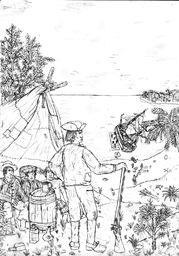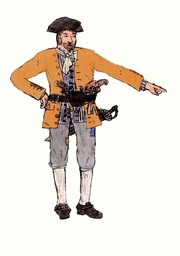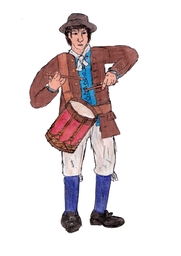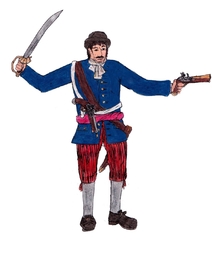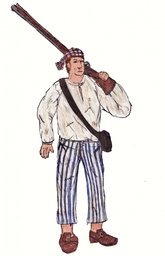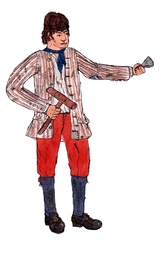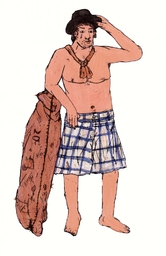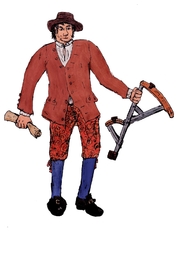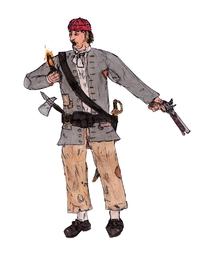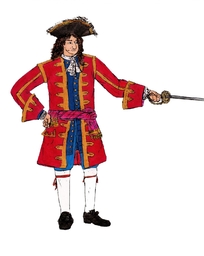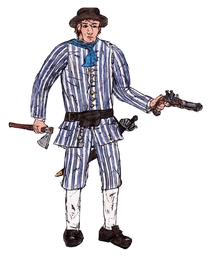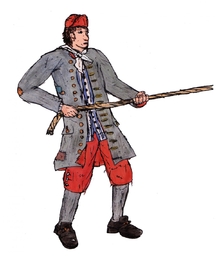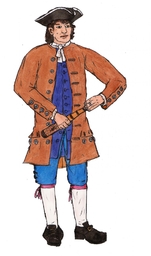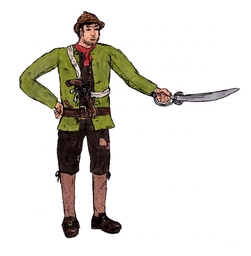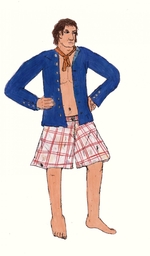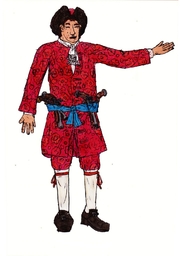-
Posts
1,118 -
Joined
-
Last visited
Content Type
Profiles
Forums
Events
Gallery
Everything posted by Swashbuckler 1700
-
(Thanks for the offer... I think about it. But, as a note I am searching these things for fun and I don't have actual academical purposes...In any case it would be interesting to see that PDF so I think about it) That is interesting. It seems that actually many of the flying gang had pirate flags with death's head and at least in Bellamy's, Blackbeard's and perhaps in Bonnet's cases (The sloop which had black flag in that attack I think, was, at least accordingly to Woodard, Stede Bonnet's Revenge, but she was not commanded by Bonnet in that battle I think (I think It was Blackbeard's man named Richards who had Revenge at his command) In any case The ship might have used Pirate colours of Bonnet in that battle) the colour of the flag was black. Also at least Bellamy's flag had crossed bones too (and perhaps the others had bones as well since the descriptions are not really detailed). Also e.g Edward England had similar flag than Bellamy. It is clear that many pirate crews had very similar flags e.g many of Low's gang had rather similar skeletons with rather minor variation. This seems not to fit completely with the idea that e.g Angust Konstam has proposed: that every pirate captain/ crew had his/their own unique "brand mark"design of the jolly Roger. It seems at least to me (with necessarily doesn't mean much) that the variation between different Jolly roger designs (colours varied so did symbols etc.) can be explained with different ideas. For example: Perhaps the symbolism was not yet clearly established as the pirate flags were still rather new phenomenon in the early 18th Century. Perhaps it was not necessarily always so personal matter for the pirates (of course e.g Robert's had his very personal and unique "ABH AMH" flag but...). The main idea I mean is that it seems that different pirates had rather similar flags and that a design was no always "a brand mark" of one particular captain. Instead it seems that at least some pirates used common symbols....
-
(Sorry if this post is difficult to read...) Something interesting I found on Benerson Little's website http://www.benersonlittle.com/_i__center_the_golden_age_of_piracy__the_truth_behind_the_myths__i___center__105984.htm I must say that while I have very little experience about Little's works he seems to be have also studied pirate flags quite a lot like Fox(e) For example he "agrees" that Jolly Roger is not likely related to the French Joli Rouge at all. About popular pirate flags (you know by now the ones always printed and most of them are not even real (likely)) he has some things to say about them (It is really sad that those likely fictional pirate flags are so popular but the just as nice real original flags rarely appear anywhere...) About John Rackham's pirate flag Little says: The purported flag of John "Calico Jack" Rackham is yet another fanciful invention. There is one legitimate pirate flag known as depicting crossed swords from 1718 off the coast of Brazil: "a cadaver (skeleton) with scattered bones and crossed sabers," but it was not Rackam's for he was not in the area. (I would personally also mention a not so legitimate but Gaop fictional flag mentioned in Defoe's book The adventures of Captain Singleton (1720) where a fictional pirate flag is described: "a black flag with cross daggers in it" but it is not still related to Rackham in any way ) Back to the flag mentioned by little. Who was the man using the flag that was used in Brasil in 1718... At least what I have read from Colin Woodard's Republic of pirates Captain Edmund/William/ Christopher Condent was sailing around that region at that time but I think he was not alone there.... Another issue related to flags (I was astonished when searching Twill that there is so few actual flag threads so I place this here. I hope it is ok) Came from Woodard's book I previously mentioned. I have had an impression that All we know of Blackbeard's real pirate flag that it had a death's head in it. I think while I cannot say any sources that the background color of that flag was said to be unknown. However there is a quote in Woodard's Republic of Pirates page 242 (of the 2007 edition) about Blackbeard's flags when he attacked "Protestant Cesar" in winter 1717-1718: "When Wyer spotted the pirates- "a large ship and a sloop with Black Flags and Death's Heads and three more sloops with bloody flags"- he called all his men on deck...." In the end notes Woodard says that in that section of Protestant Cesar his sources were: Capture of Protestant Cesar: Report of William Wyer; GHP p. 72; TSB, pp. 44-45. (GHP=General History of Pirates TSB= The Tryals of Major Stede Bonnet and Other Pirates, London Benjamin Cowse 1719) But, I wonder where the quote he used is from. Woodard doesn't say of which source it was from (was it originally in GHP or TSB). While Woodard used GHP ed. Manuel Schonhorn, Columbia, CS: University of South Carolina Press, 1972. I presume that the book was still pretty similar than the 1724 edition* and in that older version the page 72 matches as there is a description of the same Battle. However, in that page (at least in the 1724 edition) there is not the quote used by Woodard (in 1724 GHP there is only said: " Teach hoisted his Black Colours, and fired a Gun, upon which Captain Wyar and all his Men, left their Ship, and got ashore in their Boat.") So I presume the quote is originally in "The Tryals of Major Stede Bonnet and Other Pirates". Does this mean that we have an eyewitness testimony which says Blackbeard had black flags with death's heads besides bloody flags? * can be found here: http://digital.lib.ecu.edu/17001
-
Something interesting http://imageevent.com/bluboi/early;jsessionid=5xvwnbja45.frog_s?p=0&n=1&m=-1&c=3&l=0&w=1&s=0&z=2 Incredible gold slide, circa 1640, enameled in black and white, the front with symbols of mortality and reverse with symbols of immortality. The front features symbols of death - a skull and crossbones. an hour glass [tempus fugit] the lamp of the last supper a serpent-entwined staff [death and evil] and 4 instances of a 'double phi' which would have stood for the deceased person's initials, i.e., PP. Reminds later pirate flags.... However it is hardly surprising for 17th century Memento mori object I think And while we have no good evidence that Bonnet had this flag (below) the layout of the popular Bonnet's flag is very similar (I mean that whoever invented it did some research).
-
I have been wondering about one old folk-song. I heard it ifrom a interesting "source" (well it was Assassin's Greed 4 Black Flag but the song is real) and I found out using web sources that it is a real old Irish song. I have no real reason to know but I am curious. Here is said "This was a popular street song in the first half of the 18th century. The last verse may have been added later. There are several versions, including bawdy ones. For one alternate, but similar version, see Billy Taylor." One version of the lyrics (Youtube has some version too): William Taylor was a brisk young sailor, He who courted a lady fair; Bells were ringing, sailors singing, As to church they did repair. Thirty couple at the wedding; All were dress'd in rich array; 'Stead of William being married, He was press'd and sent away. She dress'd up in man's apparel, Man's apparel she put on; And she follow'd her true lover; For to find him she is gone. Then the Captain stepp'd up to her, Asking her: What's brought you here? I am come to seek my true love, Whom I lately loved so dear. If you've come to see your true love, Tell me what his name may be. O, his name is William Taylor, From the Irish ranks came he. You rise early tomorrow morning, You rise at the break of day; There you'll see your true love William Walking with a lady gay. She rose early the very next morning, She rose up at the break of day; There she saw her true love William; Walking with a lady gay. Sword and pistol she then order'd To be brought at her command; And she shot her true love William, With the bride on his right arm. If young folks in Wells or London Were served the same as she served he, Then young girls would all be undone, Very scarce young men would be! Some versions also include verse (before the captain verse): On the ship there was a battle She amongst the rest did fight The wind blew off her silver buttons Breasts were bared all snowy white What I see interesting is that, while the ballad is about love, Impressment and murder, it has some links to the popular tales of Anne Bonny and Mary Read. I am just wondering if the William Taylor song, is inspired by the famous pirate ladies. At least accordingly to the page I linked it might be early 18th century song. Perhaps it was written just after Bonny and Read were convicted. (the pictures here, except the first, are later than 18th century) She dress'd up in man's apparel, Man's apparel she put on; She amongst the rest did fight Breasts were bared all snowy white
-
Well, "Royal Rover" is a Jacobite name but didn't Bart Roberts inherit the ship called "Royal Rover" from Davis, who had (or his crew had) clearly rather clear Jacobite leanings? "Ornomde" for example was clearly a Jacobite name... Perhaps "Saint James" was Jacobite name too (but as far as I know (which doesnst' mean much in this case) it could be just christian(. Robert's later ships had more softly Jacobite suggestive names (the ships named "Royal fortune"). However, some of his ships e.g "Good Fortune" or "Ranger" doesn't sound very Jacobite to me (I , certainly, may have mistaken though). However, I am not saying that Bart Robert's had no Jacobite leanings, but it is possible that Davis and some of their crew were more Jacobite than Roberts himself (yes he used term "turnip man” of George, but it could be just defiance). Anyway, My humble opinion is that Jacobitism was seen in pirate groups mainly just because it was popular among English people in general. Pirates as outlaws could show their Jacobitism more directly (as they had nothing to fear as they were criminals already). Instead of e.g subtle white white roses they named they ships after "The pretender" or Jacobite politicians .
-
I don't have enough expertise or any reason to argue. However, one could say that there was "enemy's enemy is my friend" mentality in that case and that the pirates were desperate to have support after they lost their leaders (Jennings and Hornigold (btw I wonder if these two pirates had true Jacobite leanings as they surrendered and served George's regime in the end. Though hadn't Jennings business with governor Hamilton....?)). It could be said that it was a last resort to the pirates. And well the proposition about capturing Bermuda to harass English shipping could be seen as pirates' selfish attempt to have a new base of operation after New Providence, but now with Jacobite support (from the admiral Camocke) However, that might be futile. For what it is worth I think: There is no doubt that some if not many pirates like Vane had strong Jacobite leanings. But some pirates like Bart Roberts (whose ships' names were rather "softly" Jacobitical compared to Davis' or Cocklyn's ship's names) might have been more persons who used Jacobite symbols and rhetoric as a sign of defiance... Who knows... But is there signs e.g of William Fly's Jacobitisms? That pirate, who was not actually part of the Flying Gang, declared, before his execution, that he thought that the main cause of piracy was the malignancy of ships' masters. Also, do we have any evidence of 1690s Red Sea Roundsmen having Jacobite leanings of any kind (it would be early but why not... eh?) The studies about the subject are all focused on The Flying Gang. Indeed But it may also be largely factual like Foxe said here "You've probably figured out that there's a general fashion (or has been) for attributing to Defoe any early 18thC work of uncertain authorship. The number of works attributed to Defoe on shaky grounds (and in some cases, like Drury's Madagascar, proven beyond doubt not to have been Defoe's work) makes me take Defoe attributions with a grain of salt. Roberts' account shows a number of parallels with other historical sources, suggesting that if it is a work of fiction it's a very well researched one. There is little evidence in support of the otherwise unknown Roberts being the author, but no less evidence than there is for Defoe." Speaking about Defoe I just recently read some parts of a book (I really don't remember the name of it) that showed, with quantitative methods, that one other early 18th century book named The memoirs of an English officer is not probably written by Defoe while it has been thought. Just an example what has been thought about Defoe...
-
Yes, I will soon own the book you mentioned... The Jacobite issue was one reason why I ordered it Anyway, I though my last post needed proper references So: The book I referred and quoted was "The four years voyages of capt. George Roberts. Written by himself" printed in 1726 (can be found online on Google Books) Quoted parts are in pages 29 and 73-74 Also, there is one more study about Jacobite pirates besides Foxe's article and Woodard's book: http://muse.jhu.edu/login?auth=0&type=summary&url=/journals/histoire_sociale_social_history/v044/44.1.bialuschewski.html What is interesting is that (while the whole text cannot be read we can see the summary) is that the author, Arne Bialuschewski, had slightly different results than Foxe The dramatic upsurge of Anglo-American piracy in the Caribbean after 1715 coincided with a major Jacobite uprising in the British Isles. In the following years, pirates used Jacobite symbols and rhetoric as a sign of defiance of royal authority in the colonies and on the high seas. In 1719, several marauding gangs even cloaked their crimes as legitimate resistance to King George I and his regime. However, all references to the Jacobite cause were superficial and did not constitute active support for the cause of the exiled Stuarts.
-
I have not much to offer about this subject, but I saw that George Roberts' book was mentioned but not discussed in this context really much. While One of Lows officers indeed was clearly a Jacobite sympathizer it seems that the most of the gang weren't. Though it would be hardy surprising as Foxe noted in his study Low's gang had no clear signs of Jacobitism. The man who almost killed Roberts, when Roberts said that George was the king of England, was John Russel. What is interesting though is that at least accordingly to Roberts the man was not English, Scottish or Irish at all "...The Captain of the Scooner, whose Name was John Lopez, a Portuguese (as I was told afterwards; but then went by the Name of John Russel, pretending tho' falsely that he was born in the Northern Parts of England" I wonder why he was pretending to be a Englishman. Anyway, perhaps his Jacobite talks about the pretender were just a part of is false identity.After all Northern England was a area where Jacobitism was widespread (right?) and it would be convincing that an outlaw from Northern England would be a Jacobite sympathizer. Also, as he probably was a catholic (being a Portuguese) Jacobite ideals fits with it too. but why he would pretend to be from England. Perhaps he wanted to play a genuine Englishman because English court could perhaps be more merciful to an Englishman than to a Portuguese. Perhaps he had some English blood in his family too... Anyway what Roberts wrote after the incident with Russel (if indeed accurate) seems to fit better with the idea that pirates waged "war against the world". However, it is just one pirate gunner's opinion and perhaps Roberts made it up to make his book more interesting. "Whether it was with the Fall, or his Finger on the Trigger, I cannot tell, but the Pistol went off without doing any Damage: At which the Master and all present, blamed Russel for being so rash and hasty and the Gunner said I was not to blame; for that I drank the Health as it was first propos'd and there being no Names mention'd and King George being possess'd of the Crown, and establish'd by Authority of Parliament, he did not see but Title was the best. But what have we to do, continued he, with the Rights of Kings or Princes, Our Business here, is to chuse a King for our Commonwealth; to make such Laws as we think most conducive to the Ends we design; and to keep ourselves from being overcome and subjected to the Penalty of those Laws which are made against us. He then intimated to Russel, That he must speak his Sentiments freely, and imputed his Quarrel with me, to his being hinder'd from breaking thro' their Articles: Urging, that he would appear no better than an Insringer of their Laws, if the Matter were narrowly look'd into: And it was impossible ever to have any Order or Rule..." observ'd, if their Statutes were once broken thro'.
-
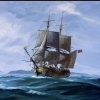
Condent's Dragons (Ships) and his identity?
Swashbuckler 1700 replied to Swashbuckler 1700's topic in Captain Twill
You welcome :) Interesting.... I was also wondering the Cassadra section of Johnson's book. Well my questions were about his identity. Was Condent Billy one Hand?Also what were his ship(s). In this thread his ship is identified as sloop with 10 guns .... -
In this documentary there is a some interesting info about pirate William Condon http://www.imdb.com/title/tt2118705/ (yes documentaries are rarely 100% accurate and this doesn't seem to be an exception) It can be, it seems at least for the time being found on YouTube when you search "pirate Island documentary" I am merely interested about one thing First of all Wiki (yes it is wiki but...) knows the man William Condon alias "Billy One Hand" who seems to be the very same man as Christoper Condent http://en.wikipedia.org/wiki/William_Condon and http://en.wikipedia.org/wiki/Christopher_Condent (neither of the articles are good unfortunately. Not many sources etc.) However, what is the mess around this man. Why he is only (practically) know of his flag that he probably never used (I think one of Foxe's results showed) while at least accordingly to the Clifford's documentary he commanded a formidable warship "Fiery Dragon" and stole a great haul of treasures. Also, Condents vessel in book "The Pirate Ship 1660–1730" by Konstam is identified as a two masted sloop and it is named "The Flying Dragon" However, in the Clifford's documentary Condon has " the Fiery Dragon" and she is a three masted warship. In the book Konstam says:" Condent proved to be one of the smarter pirates of his age. At the French-held island of La Reunion, he negotiated a pardon from the governor, and retired from piracy. Although the exact circumstances are unclear, it has been proposed that Billy One Hands, one of Condent’s crew became the new captain of the sloop, and renamed her Fiery Dragon. Whatever the origins of Fiery Dragon, she was burnt in an accidental fire while at anchor in Martinique in 1721. Archaeologists have recently uncovered her remains." What ? Firstly the documentary (and lol Wiki) says that Fiery Dragon sunk in Saint Mary Island (I think Konstam messed up with Kidd's Quedah Merchant since she had been found wrecked near Martinique and not Fiery Dragon) Secondly was Billy One hand(s) the same man as Condent and was Flying Dragon a war ship with three masts and 40 guns like in the documentary or a sloop like Konstam says? Or was it so that Flying Dragon was a sloop but Fiery Dragon a war ship? Captain Johnson's "The history of the pyrates: containing the lives of Captain Mission. Captain Bowen. Captain Kidd ... and their several crews" doesn't tell too much about the man. Here is the whole Condent section. It is not very long. "OF Captain Condent, And his Crew. CAptain Condent was a Plymouth Man born, but we are as yet ignorant of the Motives, and Time of his first turning Pyrate; he was one of those who thought fit to retire from Providence (on Governor Roger's Arrival at that Island) in a Sloop belonging to Mr. Simpson, of New York, a Jew Merchant, of which Sloop he was then Quarter-Master. Soon after they left the Island, an Accident happened on board, which put the whole Crew into Consternation; they had among them an Indian Man, whom some of them had beat; in revenge, he got most of the Arms forward into the Hold, and designed to blow up the Sloop. Upon which, some advised scuttling the Deck and throwing Grenade Shells down, but Condent said, that was too tedious and dangerous, since the Fellow might fire thro’ the Decks and kill several of them; he, therefore, taking a Pistol in one Hand, and his Cutlash in the other, leaped into the Hold; the Indian discharged a Piece at him, which broke his Arm, but, however, he ran up to and shot the Indian. When he was dead the Crew hack'd him to Pieces, and the Gunner ripping up his Belly, tore out his Heart, broiled and eat it. After this, they took a Merchant Man, called, the Duke of York; and some Disputes arising among the pyrates, the Captain, and one half of the Company, went on board the Prize; the other half, who continued in the Sloop, chose Condent Captain; he shaped his Course for the Cape de Verd Islands, and in his Way, took a Merchant Ship from Maderas, laden with Wine, bound for the West Indies, which he plundered and let go; then coming to the Isle of May, one of the said Islands, he took the whole Salt Fleet, consisting of about 20 Sail; he wanting a Boom, took out the Mainmost of one of these Ships, to supply the Want: Here he took upon him the Administration of Justice, enquiring into the Manner of the Commander's Behaviour to their Men, and those, against whom Complaint was made, he whipp'd and pickled. He took what Provisions and other Necessaries he wanted, and having augmented his Company, by Voluntiers and forced Men, he left the Ships and sailed to St. Jago, where he took a Dutch Ship, which had formerly been a Privateer; this prov'd also an easy Prize, for he fired but one Broadside, and clapping her on board, carried her without Resistance, for the Captain and several Men were killed, beside some wounded by his great Shot. This Ship proving for his Purpose, he gave her the Name of the Flying Dragon, went on board with his Crew, and made a Present of his Sloop to a Mate of an English Prize, whom he had forced with him; from hence he stood away for the Coast of Brazil, and in his Cruize, took several Portuguese Ships, which he plundered and let go. After these, he fell in with the Wright Galley, Captain John Spelt, Commander, hired by the South-Sea Company, to go to the Coast of Angela for Slaves, and thence to Buenos Ayres. This Ship he detained a considerable Time, and the Captain being his Townsman, treated him very civilly; few Days after he took Spelt, he made Prize of a Portuguese, laden with Bale Goods and Stores; he new rigg'd the Wright Galley, and put on board her several Goods. Soon after he had discharged the Portuguese, he met with a Dutch East-India Man of 26 Guns, whose Captain was kill'd the first Broadside, and took her with little Resistance, for he had hoisted the pyrates Colours on board Spelt's Ship. He now, with three Sail, steer'd for the Island of Ferdinando, where he hove down and clean'd the Flying Dragon; having careen'd, he put 11 Dutchmen on board Captain Spelt, to make Amends for the Hands he had forced from him, and sent him away, making him a Present of the Goods he took from the Portuguese Ship. When he sail'd himself, he ordered the Dutch to stay at Ferdinando 24 Hours after his Departure; threatning, if he did not comply, to sink his Ship; if he fell a second Time into his Hands, and to put all the Company to the Sword. He then stood for the Coast of Brazil, where he met a Portuguese Man of War of 70 Guns, which he came up with; the Portuguese hal'd him, and he answer'd, from London, bound for Buenos Ayres: The Portuguese mann'd his Shrouds and chear'd him, when Condent fired a Broadside and a Volley of small Arms, which began a smart Engagement for the Space of 3 Glasses; but Condent finding himself over-match'd, made the best of his Way, and, being the better Sailor, got off. Few Days after he took a Vessel of the same Nation, who gave an Account, that he had killed above 40 Men in the Guarda del Costa, beside a Number wounded; he kept along the Coast to the Southward, and took a French Ship of 18 Guns, laden with Wine and Brandy, bound for the South-Sea, which he carried with him into the River of Plate. He sent some of his Men ashore to kill some wild Cattle, but they were taken by the Crew of a Spanish Man of War; on their Examination before the Captain, they said they were two Guiney Ships, with Slaves belonging to the South-Sea Company, and on this Story were allowed to return to their Boats: Here five of his forced Men ran away with his Canoe, he plundered the French Ship, cut her adrift, and she was stranded. He proceeded along the Brazil Coast, and hearing a Pyrate Ship was lost upon it, and the pyrates imprisoned, he used all the Portuguese, who fell into his Hands, who were many, very barbarously, cutting off their Ears and Noses; and as his Master was a Papist, when they took a Priest, they made him say Mass at the Main-mast, and would afterwards get on his Back and ride him about the Decks, or else load and drive him like a Beast. He from this went to the Guiney Coast, and took Captain Hill in the Indian Queen. In Luengo Bay he saw two Ships at Anchor, one a Dutchman of 44 Guns, the other an English Ship, called the Fame, Captain Bowen, Commander; they both cut and ran ashore, the Fame was lost, but the Dutch Ship, the Pyrate, got off and took with him. When he was at Sea again he discharged Captain Hill, and stood away for the East-Indies. Near the Cape he took an Ostend East-India Man, of which Mr. Nash, a noted Merchant in London, was Supercargo. Soon after he took a Dutch East-India Man, discharged the Ostender, and made for Madagascar; at the Isle of St. Mary, he met with some of Captain Halsey's Crew, whom he took on board with other Stragglers, and shaped his Course for the East-Indies, and in the Way, at the Island of Johanna, took, in Company of two other pyrates he met at St Mary's, the Cassandra East-India Man, commanded by Captain James Macragh; he continued his Course for the East-Indies, where he made a very great Booty, and returning, touch'd at the Isle of Mascarenas, where he met with a Portuguese Ship of 70 Guns, with the Vice-Roy of Goa, on board. This Ship he made Prize of, and hearing she had Money on board, they would allow of no Ransom, but carried her to the Coast of Zanguebar, where was a Dutch Fortification, which they took and plunder'd, razed the Fort, and carried off several Men who enter'd voluntarily. From hence they stood for St. Mary's, where they shared their Booty, broke up their Company, and settled among the Natives: Here a Snow came from Bristol, which they obliged to carry a Petition to the Governor of Mascarenas for a Pardon, tho’ they paid the Master very generously. The Governor returned Answer, he would take them into Protection if they would destroy their Ships, which they agreed to, and accordingly sunk the Flying Dragon, &c. Condent and some others went to Mascarenas, where Condent married the Governor's Sister-in-Law, and stay'd some Time; but as I have been credibly inform'd, he is since come to France, settled at St. Maloes, and drives a considerable Trade as a Merchant." What Johnson said about (".....he met with a Dutch East-India Man of 26 Guns, whose Captain was kill'd the first Broadside, and took her with little Resistance, for he had hoisted the pyrates Colours on board Spelt's Ship.") Condent's ship capture of a large ship makes it look like Condent captured this ship and she is the war ship Clifford's documentary described. It seems that this was The Fiery Dragon and his original vessel, a sloop, was The Flying Dragon.... I am probably wrong about one or more things but at least I think Condent had been seriously underestimated as a pirate. Seems to be one of the grand messes of the pirate history.... At least Konstam got confused about it and not just me
-

swearing among pirates alike
Swashbuckler 1700 replied to Swashbuckler 1700's topic in Captain Twill
In his book "The Pirate Hunter: The True Story of Captain Kidd" Richard Zacks said about cursing "Pirates cursed a lot and often wore wild outrageous clothes. On shore, for instance, in Boston, in 1691, shoemaker William Smith, was overheard saying to his wife, "God damn you!, the Devil rot you!, and "Pox take you". For this, he was sentenced to two hours in the stocks. When William Snelgrave was captured by pirates off the coast of Africa, he was astounded by the "execrable oaths and blasphemies [which] shocked me to such a degree that in Hell itself I thought there could not be worse." One pirate captain in his cups, vowed: "If we swing our grappling hooks onto the clouds and attack Heaven itself, I'd aim my first shot at God."" The author also wrote "A member of Bartholomew Roberts crew was being led to the gallows in Cape Coast Castle off West Africa. David "Lord" Symson recognized a woman's face in the crowd, one Elizabeth Trengrove, a passenger on a ship they had captured. "I have lain with that bitch three times," bragged the unrepentent pirate, "and now she has come to see me hanged." But who was the captain who said "If we swing our grappling hooks onto the clouds and attack Heaven itself, I'd aim my first shot at God."? The author does not say -
I have not found anything about that Blackbeard image... unfortunately. I have been wondering the same thing but here is some pictures again Juan Fernandez island 1682 From a book of sailing directions of 110ff: 'The South Sea Waggoner shewing the making & bearing of all the coasts from California to the Streights of Le Maire done from the Spanish originall by Basil Ringrose'. A smuggling [pirate?] lugger chased by a naval brig circa 1825 "The Wapping Landlady" shows a Inn scene with sailors recently come ashore circa 1743 Destruction of Chuiapoo's pirate fleet, 30 September 1849 painting made in the 19th century Mr. Garrick in the Character of a Drunken Sailor circa 1750-1785 "Kartagena, een stedeken in Zuidamerika, in de Provintie Zuinbaya, niet verre van de rivier Canca" I think it means just Cartagena. A Dutch print circa 1702 Portrait of Jean Baptiste du Casse (1646- 1715), late buccaneer, admiral and the French governor of Saint-Domingue circa 1700 Some Dutch ships by Willem van de Velde the elder around 1660s
-

About Captain Martel and his pirate gang
Swashbuckler 1700 replied to Swashbuckler 1700's topic in Captain Twill
I have also a question: Who is the pirate captain Kennedy mentioned here and active in 1716? Surely not Walter Kennedy who was in crew of Davis' and Robert's in 1718-21 and who was a captain later... I also think that the Flag attributed to Walter Kennedy was the one used by this Kennedy who operated in 1716 I wonder if there were two or more Kennedys and similar fail has happened than with captain Moody and Roberts' crew member Christopher Moody? At least the description of this 1716 Kennedy's flag fits to the flag usually attributed to Walter Kennedy Like captain Evans told in his letter to Johnson "in which was the Figure of a Man, with a Sword in his Hand, and an Hour-Glass before him, with a Death's Head and Bones" -
Surprisingly I didn't found proper thread for this : John/ James Martel was not a particularly notable pirate (though at least accordingly to Wiki he commanded 22 gun ship which is quite large actually) At first I found an interesting section about this pirate in The history of the pyrates: containing the lives of Captain Mission. Captain Bowen. Captain Kidd ... and their several crews (1728) link http://digital.lib.ecu.edu/17002 I appears that a person who had more knowledge about Martel or actually his pirate gang under Captain Kennedy sent a Letter to Johnson since the original edition of the book contained errors. The letter was published in this 1728 Volume. Pages 330-335 This is the beginning of the letter (I think it is indeed a letter) To Captain Johnson. SIR, THOUGH I can contribute nothing to your Second Volume of pyrates you have (as I hear) in Hand, yet, by your Character of Veracity, I perswade my self I shall oblige you, in rectifying a Mistake you made in your first. In the Life of Captain Martel you say, the Greyhound Galley of London, which I then commanded, fell into the Hands of that Pyrate, who plunder'd her of some Gold Dust, Elephants Teeth, and 40 Slaves. The latter Part of this is just, except the Elephants Teeth, of which I lost, I think, none; but you are misled in the former, for Martel's Company had deposed him, on Account, as they themselves told me, of his Cruelty; had given him, and those who were willing to follow his Fortunes, a Sloop, and, sending him away, chose a more righteous in his Place, whose Name was Kennedy, by Descent an Irishman, by Birth a Spaniard of Cuba, and a Hunter.... and this is the end signature I am, SIR, Your very humble Servant, J. EVANS. Feb. 2. 1727-8. P.S. Four of my Men took on with the pyrates, though I remember the Names of two only, Bryant Ryley, John Hammond. But here is an interesting description of a "battle" and flags, if indeed true like the Writer says On the 16th of October 1716, about 10 Leagues S. S. W. from the Island of Monna, in the grey of the Morning, my second Mate came down and acquainted me, that a Ship was almost on board us. We then steer'd about W. half South, and the Pyrate stood to the S. E. His coming very near us made us edge away from him, and call out to desire he would keep his Luff, or he would be on board us. No Answer was given, and not a Soul appear'd on his Decks, but the Man at the Helm, and about two more; however the Greyhound got clear, and crowded, as usual, for a Market. As soon as the Pyrate got into our Wake, she wore, and made all the Sail she could, by which Means she soon came up with us (for she was clean, and we foul) and clewing up her Sprit-Sail, fir'd a Gun with Shot, and at the same Time let fly her Jack, Ensign and Pendant, in which was the Figure of a Man, with a Sword in his Hand, and an Hour-Glass before him, with a Death's Head and Bones. In the Jack and Pendant were only the Head and Cross Bones. I did not think fit to shorten Sail, which occasioned a second Shot from the Pyrate, which went through our Main Top-Sail. Upon this I consulted my Officers, and they advised the shortening sail, as we were no Way in a Capacity to make any Defence..... It goes on but I find the flags interesting... Sadly no description of the colour. But, we know that by the time the letter was written and the Johnson books (middle/late 1720s) the Black flag was rather universal pirate symbol. I think that if the flag was not black he would have mentioned it. (As the black flag is used as pirate flag synonym in Johnson's books). Anyway it might well have been red, yellow, green etc. or perhaps the flags and pedants had different colors... Also, here is an interesting part where the writer tells what ha happened earlier and the return to the period of his captivity The Pyrate, a little before I was taken, had met with two interloping Dutch Men, supposed to be bound for the Main, who gave him a rough Entertainment, and made him glad to sheer off. The Weymouth had two Women Passengers on board; how they pass'd their Time I need not say; though, I fancy, as they had formerly made a Trip or two to the Bay, there was no Rape committed. Notwithstanding the melancholy Situation I was in, I could not refrain laughing when I saw the Fellows who went on board the Greyhound, return to their own Ship; for they had, in rummaging my Cabbin, met with a Leather Powder Bag and Puff, with which they had powder'd themselves from Head to Foot, walk'd the Decks with their Hats under their Arms, minced their Oaths, and affected all the Airs of a Beau, with an Aukwardness would have forced a Smile from a Cynick. When I was permitted to return on board the Greyhound, and prosecute my Voyage, I found all my Papers torn, and every Thing turn'd topsy-turvy; but this was nothing to their leaving all my Negroes out of Irons, of whom I was more in fear than I had been of the pyrates; for, among them, the Captain's Humanity protected us; but we could expect no Quarter from the Negroes should they rebel; and, in such Case, we had no Prospect of quelling them, for the pyrates had taken away all our Arms, and by opening a Cask of Knives, which they had scatter'd about the Ship, they had armed the Negroes, one of whom had the Insolence to collar and shake one of my Men. I therefore called my People aft, and told them, our Security depended altogether on our Resolution; wherefore arming selves with Handspikes, we drove the Negroes into the Hold, and afterwards calling them up one by one, we put on their Irons, which the pyrates had not taken with them, took away their Knives, and, by these Means, arrived safely at our Port.
-
Some pictures of PEter monamy which Ihave not shared yet... at least most of them should be like that... (Peter Monamy was an English marine painter who lived between 1681 and 1749.(So practically in GAop)) An English East Indiaman 1720 Peter Monamy The flagship Royal Sovereign saluting at the Nore. First Half of the 18th Century An English Royal Yacht Standing Offshore in a Calm. Circa 1730 Seascape with shipping in a naval battle Shipping in a Calm. Made between 1700 and 1725
-

How it was possible to identify the pirates?
Swashbuckler 1700 replied to Swashbuckler 1700's topic in Captain Twill
I recently found an interesting case. It is a rare example of that pirates were indeed identified because of their personal appearance. I am not claiming that this was never a rule but this case is interesting. I was reading Rickhard Zacks' classic book "The Pirate Hunter: The True Story of Captain Kidd" I won't quote it directly as the book I am reading is a local translated version (However it appears to be fairly accurately translated.) There was a case which happened in The Cape of Good Hope in late 1699. Pirate Robert Culliford and some other pirates had just received a pardon from Captain Thomas Warren of the pink "Vine" and he pirates were travelling on-board the Warren's vessel as free men. However Certain Mathew Lowth of the East India Company stopped their ship and he got suspicious since the men (Culliford and other pardoned pirates) were wearing "Company's cloth" (meaning fine Indian cloth the EIC used to trade). There was some disagreement about the pardon of the pirates but after a long argument Warren with the pirates were able to leave in peace. Culliford was relatively a successful pirate, He captured a grand prize Great Mohammed and some other ships so it is logical that he and his men had expensive stolen cloth. I find no reason to doubt Zacks who referred e.g to Lowth's logbook (though not in this particular section) What is also notable, in my humble opinion, is that the cloth, accordingly to Zacks was sewn as breeches or other typical clothing. The pirates were wearing homemade clothes of the stolen cloth. The sewn clothes like breeches were typical pieces of clothing that sailors used: the only difference seemed to be the cloth and not the actual style of clothing. I think that this thread is the correct place for this :) -

'Black Sam' Bellamy and the Wydah
Swashbuckler 1700 replied to TalesOfTheSevenSeas's topic in Captain Twill
I found something interesting (I think) From here http://wc.rootsweb.ancestry.com/cgi-bin/igm.cgi?op=GET&db=oldmankew&id=I8306 A rather superficial thing but related to Bellamy's persona and his appearance. However I don't feel that the text is really realistic. However, where is this section based on? Is it completely made up has it even some evidence to support it? "He [bellamy] made a dashing figure in his long deep-cuffed velvet coat, knee breeches, silk stockings, and silver-buckled shoes; with a sword slung on his left hip and four pistols in his sash. Unlike some of his fellows, Bellamy never wore the fashionable powdered wig, but grew his dark hair long and tied it back with a black satin bow." -
From the album: Realistic pirate art
This picture is based on this old woodcut http://teachhistory.com/wp-content/uploads/2009/12/pirate_lowther.jpg But I did some changes. These pirates of The Caribbean or why not Indian Ocean are careening their ship. The ship is not totally on land as the pirates are practicing a different method of careening where the ship is partly floating (for example like here http://upload.wikimedia.org/wikipedia/commons/thumb/a/af/An_Old_Whaler_Hove_Down_For_Repairs,_Near_New_Bedford.jpg/800px-An_Old_Whaler_Hove_Down_For_Repairs,_Near_New_Bedford.jpg) -

Realistic pirate art
Images added to a gallery album owned by Swashbuckler 1700 in Pub Members Gallery
Title says it all. Because there is very little pictorial material about pirate appearance available I have drawn several characters that I think are rather realistic based on what I have learned. These are not meant to me romantic, but more like a attempt to figure out the real look of pirates of the late 1600s and early 1700s. I should move on to ships and such from this topic I think. They are more picturesque. -
Really interesting :) Oh Here is the on of them in larger shape
-
Here is a little about that picture Made by Jacques-Antoine Delaistre (1690-1765) circa 1721 http://www.photo.rmn.fr/c/htm/CSearchZ.aspx?o=&Total=304&FP=51192502&E=2K1KTSJLISF91&SID=2K1KTSJLISF91&New=T&Pic=11&SubE=2C6NU0PI4DOX
-
More pictures Well not completely naval but related to The 18th century Caribbean. British occupied Havana, Cuba, during the Seven Years War in 1762 Artist of following pictured is Dominic Serres (1719–1793) So here some works about the occupation of Havana made around 1770s The Capture of Havana, 1762: the Landing, 7th June The British Fleet Entering Havana, 21 August 1762 The Captured Spanish Fleet at Havana, August-September 1762 The Capture of Havana, 1762: The Morro Castle and the Boom Defence Before the Attack The Cathedral at Havana, August-September 1762 The Capture of Havana, 1762: the English Battery Before Morro Castle (I love the giant cactus) The Piazza at Havana (the men with black hats, canes and blue coats are surely sailors of the mid-late 18th century) And now another work with different theme By a Castro, Lorenzo (Active c. 1664 - died c.1700?) "A Sea Fight with Barbary Corsairs" made around 1680s
-

New Osprey book about Blackbeard
Swashbuckler 1700 replied to Swashbuckler 1700's topic in Captain Twill
Facepalm I found one of the illustrations in larger size. (From an odd site but it is from that book nevertheless) And what I see http://s5.goodfon.ru/image/502669-3194x2105.jpg -earrings -tattoos -cavarly style boots -blackbeard has a cutlass of later fashion What is remarkable is that "Pirate:The Golden Age" Book had none of these in its illustration ( I am certain as I have the book). Compare that with the earlier book's illustration http://www.edinburghwargames.com/J57%20Images/Battlecolor.jpg Why it has changed back to the more inaccurate style? The Pirate The Golden Age was, in my humble opinion, even excessive realistic with both text and illustrations. Anyway I think I will buy the new Blackbeard book someday..... -
Some pictures... The first is only slightly pirate related.He looks silly in modern perspective as so many other gentleman's of Gaop. Nothing really special though. Fernando de Alencastre, 1st Duke of Linares who was the governor of New Spain c. 1641, Spain—June 3, 1717, Mexico City. Jesus of Lübeck. She was John Hawkins' vessel in 1560s Later that Gaop. 1790s -early 1800s caricature but NMM has no date with it it... The maker, John Fairburn,of the image lived then and made other similar works so the date is pretty much like that... as a detail the socks seems to be striped in some way... The Tobacco Box, or Jack taking a Quid of Comfort in a Storm Same with colour "An English Ship in a Gale Trying to Claw off a Lee Shore" 1670s by Willem van de Velde. Map of Acapulco circa 1685 (North is up, like in most modern maps, which seems to be rather rare in old maps) Another similar map now of Naguala A probable portrait Lars Gathenhielm (1689–1718), who was a Swedish merchant and privateer Great Northern War.
-
I first came across this thing in a local history magazine. Then it was the Google's turn and I was surprised to find a Wikipedia article about it. So the Norman Island was apparently a real island and still is. Also at least some parts of the treasure article is true. However does anyone know how much of the story is evidently real? The article had for example a wrong link to a person (Owen Lloyd) so I am unsure about its accuracy. I am only curious and I saw that this thing has no thread yet so in case there is a conversation to come....


